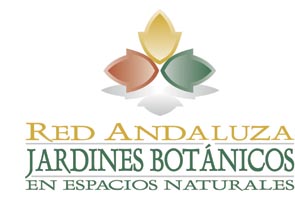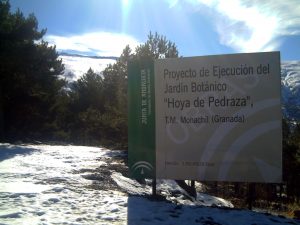Hoya de Pedraza. RAJBEN, SPAIN

- Name: Hoya de Pedraza
- Phone: 697 955 249
- Website: http://www.cma.junta-andalucia.es/medioambiente/site/portalweb/m
- Email: jbotanico.pedraza.cmaot@juntadeandalucia.es
- Opening hours: 22nd March – 31st May: from Tuesday to Sunday (10:00 am – 3:00 pm).
1st June – 31st August: from Tuesday to Sunday (9:00 am – 3:00 pm).
1st September – 30th November: from Tuesday to Sunday (10:00 am – 3:00 pm).
Closed: on Mondays. During the months of January, February, March (until the 21st) and December.
- Institution: Public. Consejería de Medio Ambiente y Ordenación del Territorio –CMAOT– (Andalusian Environment and Territory Ordinance Ministry).
- Director: Carmen Rodriguez Hiraldo
- Facilities:
The garden’s associated infrastructure are: a workshop, toilettes, gardening storeroom, information point and administration office. All of them inside the area.
The features are:
-Interpretative trails,
-A workshop for environmental activities,
-Reception hall,
-Parking area. - Number of Species:
340
- Opened in Year: June 2017
- Conservation programmes: •To localize and follow flora taxa as well as protected, endangered, endemic and rare fungus natural from Andalusia.
•Seeds and other propagules collection, used for:
- The development and implementation of germination protocols.
- The representation of most important vegetal species.
- Preservation of these vegetal species in Andalusian Vegetal Germplasm Bank.
- Reintroduction or reinforcement of the vegetal species population in the environment through different actions .
•The maintenance of conservation and genetic recovery collections.
•The participation in two recovery Plans approved by the Andalusian Environment and Territory Ordinance Ministry. Pteridofitos, and high peaks.
- Research Programs:
We can highlight the collaboration with research centers as:
•CSIC (Centre of Spanish Scientific Research Center), and universities to study protected and endangered taxa native from the Andalusian community. The collections from the botanic and mycological gardens are important instruments for the elaboration of scientific studies since Reseach Centers and universities have available within the Botanic Garden genetic material located deep within the nature where unique specimens meet. Indeed, Research Centres as the CSIC, other botanical gardens, private foundations, companies and different universities take advantage of the human and technical resources available for carrying out different projects. Among them, we can highlight some studies concerning on pests, the effect of the herbivory, testing with special substrates or the monitoring of invasive species.
•The Spanish Society of Plant Biology and Conservation (SEBICOP), in the process of monitring endangered species of wild flora (SEFA Project).
•Permanent member of the Iberian-Macaronesian Association of Botanic Gardens). - Education Programmes:
Among others, we can mention the follwing educational programmes:
•Aldea Programme: a programme developed in collaboration with the Spanish Ministry of Education. Its aim is to promote the integrated development of educational initiatives focused on the conservation of natural resources and the encouragement for sustainable development in the field of de Andalusian educative community. The aim is to create a more environmentally-friendly society and fairer and more solidary world. Thanks to this, an integral education can be accomplish according to UNESCO‘s four pillars of learning: Learning to be, Learning to live together, Learning to know and Learning to do.
•Training courses for professional sectors who are required to hold a technical training certification in terms of endangered flora and of interest.
•Activities and workshops focused on different themes and levels suitable for everyone as a way to get closer to Andalusian floristic values: photography courses, traditional uses of plants, knowledge of certain kinds of vegetable groups, etc.
•Guided visits in order to know the content of the different botanical gardens.
•Permanent workshops with groups which are allowed to analyse the garden’s dynamics at different times of the year.

 Hoya de Pedraza Botanical Garden is located in Granada’s access to Pradollano ski resort, 30 minutes away from the city. It is named after the public mount where it is placed. The mount, in turn, receives its name because of the traditional practice of growing crops in the mountain for subsistence. La Hoya (a wide valley) was a gently sloped area or with a flat hillside, with water supply and an optimal fertile soil.
Hoya de Pedraza Botanical Garden is located in Granada’s access to Pradollano ski resort, 30 minutes away from the city. It is named after the public mount where it is placed. The mount, in turn, receives its name because of the traditional practice of growing crops in the mountain for subsistence. La Hoya (a wide valley) was a gently sloped area or with a flat hillside, with water supply and an optimal fertile soil.
In both the natural space of Sierra Nevada and in the limiting area between the National Park and the Natural Park, the visitor will be able to walk through two different vegetation zones: the calcareous and the siliceous vegetation. They represent the areas of the garden: the Biogeographic Sector Alpujarreño-Gadorense and the Biogeographic Sector Nevadense, respectively.
The Alpujarreño-Gadorense Biogeographic Sector expands through the lowest coasts from the natural and historical area of the Alpujarra, relative to the provinces of Almeria and Granada, and to the mountains parallel to the sea: from Almeria’s surroundings up to Motril (Gádor y Lújar-La Contraviesa).
The Nevadense Biogeographic Sector is characterized by its acid soil. It spans throughout la Sierra de Los Filabres and almost the entire area of Sierra Nevada.
This vast and diverse area offers to the visitor the opportunity to see completely different plant specimens and vegetation formations, some of them directly related with artic flora and alpine-artic; and other ones that crossed the arid and dry area of North Africa, which covers the Mediterranean.
